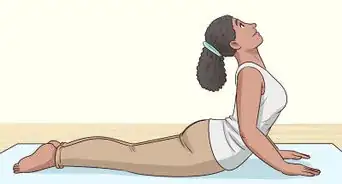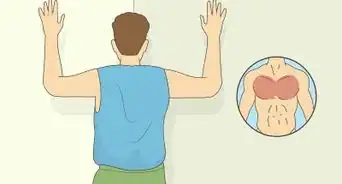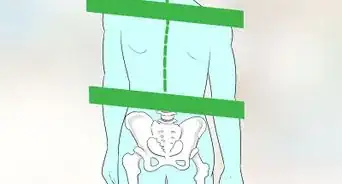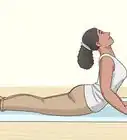This article was co-authored by Mayami Oyanagi. Mayami Oyanagi is a Physical Therapist and the owner of PT STOP Physical Therapy & Wellness, an individualized physical therapy practice in Los Angeles, California. With over 14 years of experience, Mayami specializes in orthopedic injuries, manual therapy, and sports medicine. She holds an MS in Physical Therapy from the University of Hartford. Mayami is also a board certified Orthopedic Clinical Specialist. She treats the root cause of her client’s problems by utilizing biomechanical assessments.
This article has been viewed 50,647 times.
Good posture is very important when talking about maintaining good health. It can be as important as having a good diet, exercise, proper sleep, and avoiding harmful things such as drugs and alcohol. Having good posture helps with properly aligning your bones, as well as making sure your joints, muscles, and ligaments are working the way they are intended to. If you are experiencing any form of back pain, chances are your posture has room for improvement.
Steps
Identifying Poor Posture
-
1The first thing you should do is to try to identify any issues with your current posture. Many postural issues happen due to the muscles used to hold a joint in place are out of balance. Improving your posture does not require much, but for this step you will need a mirror.
- Begin by doing a standing assessment of your posture by standing in front of a mirror with form fitting clothing.
- Do this assessment barefooted
- Relax your body and try not to force yourself to stand in a manner that you would not normally stand.
-
2Try to identify any deviations that you could have in your head and neck area.
- Your chin should be parallel with the floor.
- Your head should be erect.
- When looking from a side view, your head is erect and not slouch either forward or backwards.
Advertisement -
3See if there are any deviations in your shoulder area.
- The shoulders should be parallel with each other.
- When looking from the side view, your shoulders should be line up with your ears
- If one side is more elevated than the other, there is an issue. That means that your trapezius muscle is overactive.
-
4Identify any issues with the alignment in chest and upper back.
- Your chest should be up.
- You should be able to see three distinct curves behind your back.
- The ribs should be over the hips.
-
5Identify any issues with the alignment in your lower half.
- Your lower back should have a slight curve.
- Your pelvis and spine should be in a neutral position.
- Your lower abdomen should be flat.
-
6Look at the alignment of your feet and ankles.
- Like your neck shoulders, chest, and back, your feet and ankles also need to have proper alignment.
- Your feet and ankles should be faced forward, and not turned inward or outward.
Improving Postural Issues
-
1Once the problems with your posture have been identified, work on fixing them. Try to do daily activities evenly on both sides of your body
- To improve to alignment of your neck, performing daily activities to strengthen the muscles in your neck
- This can include chewing, lifting, pulling, and carrying objects evenly on both sides of your neck
- To improve alignment in your shoulders, try performing daily activities evenly on both sides of your shoulders
-
2Try to avoid doing activities that may cause injury or strain your body. Injuries are a common cause of poor posture, so try to avoid doing things that may unintentionally injure your back
- When picking up heavy objects, lift with your knees, not your waist
- When carrying heavy objects, keep them close to your chest to relieve any added pressure to your lower back and puts more pressure on your arms and chest
- Avoid wearing overweight purses or backpacks over one shoulder
- Do not persist on doing exercises if you experience pain, pulled muscles, or joints clicking
-
3Do activities that will support your spine.
- After menopause, women are more likely to have more weakened muscles around the spine compared to men.
- Try doing exercises that stimulate your back muscles. Go lighter on bench presses and push up exercises, and focus more on exercises that simulate rowing or pulling are recommended.
-
4Do exercises that will strengthen your core muscles. Improving your core strength refers to your abdomen and pelvic area.
- These muscles are the foundations needed for good posture
- Yoga and Pilates are great activities to do in order to build your core strength
-
5Try to develop better habits while both sitting and standing.
- Try not to slouch when using a computer.[1]
- Place both feet firmly on the ground when you're sitting in a chair.[2]
- Keep your knees and hips bent at a 90-degree angle while seated.[3]
- Get into the habit of not slouching while walking. Keep your head up, chest out, and shoulders back.
- Keep your eyes looking ahead and not at the ground.
-
6Try to improve your overall eating habits. Eating healthy helps maintain bone health and overall improve your posture.
- Calcium has well known bone benefits.
- Vitamin D is also important for bone health.
-Step-1-Version-2.webp)
-Step-2-Version-2.webp)
-Step-3-Version-2.webp)
-Step-4-Version-2.webp)
-Step-5-Version-2.webp)
-Step-6-Version-2.webp)
-Step-7-Version-2.webp)
-Step-8.webp)
-Step-9.webp)
-Step-10.webp)
-Step-11.webp)

-Step-12.webp)

























































